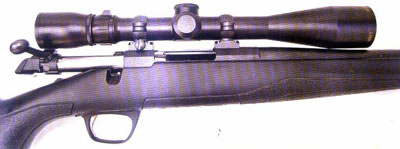
Lynx have been giving us good reliable scopes at a value for money price for some time now and on first impressions of this model 4-12x40, their stable is getting bigger. Hunting scopes with objective or saddle focus leave me a little perplexed. There are very few hunting situations that these extra features don't just take your mind off the job at hand and end up costing you missed game as you are too busy playing to do what you are out there for - concentrating on pulling the trigger.
The very slick setup with Leupold bases and super low rings, and there is clearance everywhere. Note how the objective gets close to the barrel quite a way down from the knox form. The rifle was decidedly easier to shoot with the scope this low. Also note on the objective what appears to be the joint in the taper. |
 |
However, I am prepared to concede there are the odd hunting / trophy situation where I might dare to take a variable. The most impressive feature this scope is its relatively small stature, with a 47.4mm outside diameter (OD) objective housing which means that it can be mounted relatively low for good fit.
The overall length is starting to get a little long at 352mm, but that will work in your favour because the full diameter of the objective is a fair distance in front of the action, and therefore will allow you to mount the scope lower because it is out past the knox form.
The scope we have for review is a 4-12x40 variable powered hunting scope and not a target / varmint scope. The reticle is a standard duplex style. Construction is a little different from the other professional mono tube scopes from Lynx, in there appears to be a joint about three quarters of the way up the taper from the tube diameter to the objective diameter. The main tube has a generous 152mm (6”) of length so it will fit on any .30-06 length action.
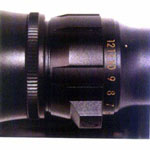 |
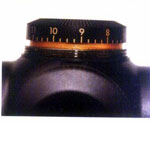 |
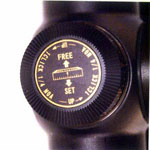 |
The well fluted power ring and the tactical location / traction lug on the power ring. |
The vertical turret with the adjusting ring in the down or drive position |
The instructions on the top of the vertical turret. |
The adjusting turrets are Lynx’s new resettable style so they can be zeroed by lifting the knurled adjusting ring which disconnects the drive spindle so the dial can be zeroed after sighting in is complete. When the adjusting ring is pushed down it reconnects with the adjustment and any further adjustment will be easily seen. This new model has very traditional straight clean lines. The power ring has generous fluting and a location / traction lug for tactile ocular focus, which is good to see. Obviously Lynx designers understand that fast focus is a silly idea.
The 4-12x40 was mounted on a 6mm BR and sighted in. The first 5 shot group on 12 power was 0.305” and the group on 4 power went into 0.63”. The power change test had all 6 shots of 2 on 4x;2 on 12x; and 2 on 8x going into under 0.5” at 100 yards which would give me a fair bit of confidence in the field that regardless of where I had the power ring set that the point of aim would be spot on. The round target test, 12 clicks were chosen with a resultant point of impact movement of just fractionally more than the 3” which should have resulted. The important thing is the first and last 2 shots were pretty close to perfect, although the second last shot was a little wayward (shooter error) the 4 shots were in 0.604”.
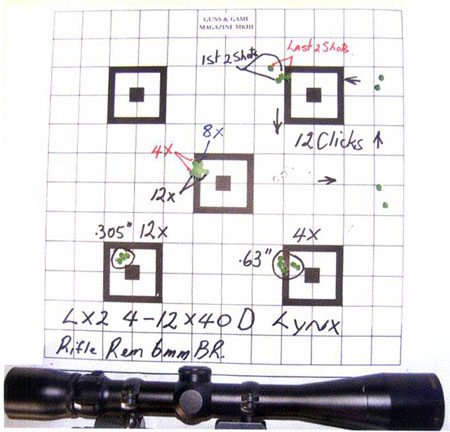 |
The test target for the Lynx just reinforces the Lynx value for money moniker I gave it at the top of this report. It is capable of shooting groups as good or better than any rifle you might put it on and the power change test would give me lots of confidence in the field that whatever power I chose it could be relied on to be spot on. With 2 shots on high, low and intermediate power giving a resultant group of 0.5" for the 6 shots. |
Optical performance is pretty good with edge to edge clarity being sharp throughout the magnification range. The only thing that you might pick is the eye relief changes with the power so obviously when you change the power, eye relief must be changed to achieve the perfect edge to edge clarity. The eye relief range is 82mm on 12 power to 113mm on 4 power. Obviously, if you are mounting a variable scope on a heavy recoiling rifle set the scope on maximum power when setting eye relief, or a Weatherby eyebrow may result. (Read: make sure the scope is as far away from your eye as practical). These measurements were arrived at using a small torch shone in the objective lens and a box moved back and forth until the torch light gives a crisp sharp image on the box. This is absolute eye relief when measured from the very back edge of the ocular housing to the box (your eye). This difference will only be very noticeable when you are using the rifle on the bench and has little or no consequence in the field.
Field testing ended up happening as night as I had a lightforce spotlight to test, and well it just wouldn’t do to try a spotlight without a rifle. I remounted the Lynx on the Browning X-Bolt in Leupold bases and Leupold Super Low Rings for an almost perfect fit. I shot the rifle in at 50 yards, and away I went with the first 2 shots yielding two foxes, and then a fidgety fox saw me miss a couple of shots, then another fox and a hare.
The three foxes and hare taken with the Browning X-Bolt and 4-12x40 Lynx while testing both the lightforce spotlight and the scope / rifle combination. |
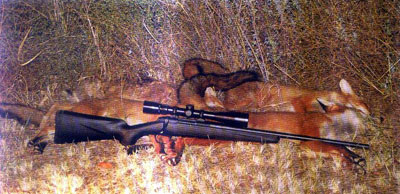 |
In conclusion the performance on the target with the 6mm BR would give me a fair amount of confidence that this new scope from Lynx could be relied on to give good reliable performance in the field and on the bench for many years to come.